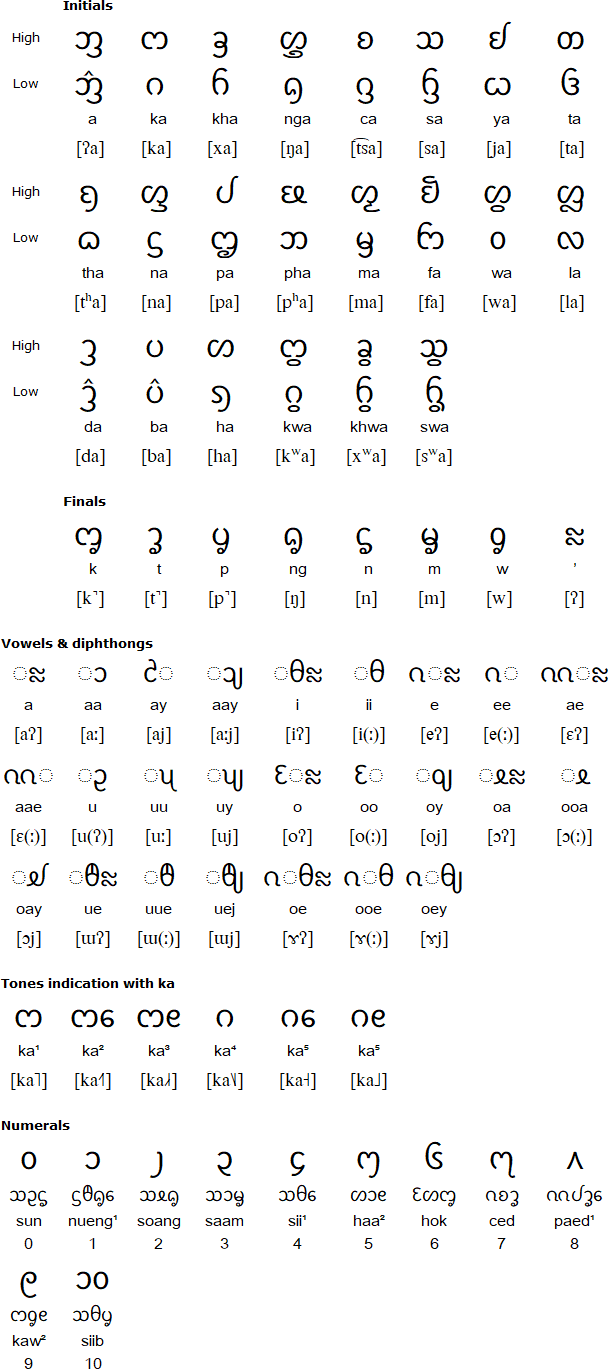The New Tai Lue script was developed in China during the 1950s. It is based on the Old (Traditional) Tai Lue script, which had been in use since about 1200 AD. Between 1950 and the early 1980s the Chinese government promoted the new script as a replacement for the old script. However since the 1980s the Tai Lue in China have been allowed to choose to teach either the new or the old script. The new script is used exclusively in Jinghong, so could be called the New Jinghong Tai Lue script, and is used for shop and street signs. Few people can read it.
The traditional Tai Lue script, which is very similar to the Lanna alphabet, is still used in Burma, Laos, Thailand and Vietnam. It is also also known as Xishuangbanna Dai (ᦟᦲᧅᦷᦎᦺᦑᦟᦹᧉ) or Simplified Tai Lue.

Download an alphabet chart for New Tai Lue (Excel)
![]()
Information about Tai Lue | New Tai Lue script | Numbers
Information about the Tai Lue script
https://en.wikipedia.org/wiki/New_Tai_Lue_alphabet
http://www.seasite.niu.edu/tai/TaiLue/
http://www.skyknowledge.com/tailue.htm
https://r12a.github.io/scripts/newtailue/
New Tai Lue fonts
https://fontlabcom.github.io/getgo-fonts/zotosans-newtailue/
http://scripts.sil.org/DaiBannaSIL
https://fontzone.net/font-details/microsoft-new-tai-lue
Ahom, Aima, Arleng, Badagu, Badlit, Basahan, Balinese, Balti-A, Balti-B, Batak, Baybayin, Bengali, Bhaiksuki, Bhujimol, Bilang-bilang, Bima, Blackfoot, Brahmi, Buhid, Burmese, Carrier, Chakma, Cham, Cree, Dehong Dai, Devanagari, Dham Lipi, Dhankari / Sirmauri, Ditema, Dives Akuru, Dogra, Ethiopic, Evēla Akuru, Fox, Fraser, Gond, Goykanadi, Grantha, Gujarati, Gunjala Gondi, Gupta, Gurmukhi, Halbi Lipi, Hanifi, Hanuno'o, Hočąk, Ibalnan, Incung, Inuktitut, Jaunsari Takri, Javanese, Kaithi, Kadamba, Kamarupi, Kannada, Kawi, Kharosthi, Khema, Khe Prih, Khmer, Khojki, Khudabadi, Kirat Rai, Kōchi, Kodava Lipi, Komering, Kulitan, Kurukh Banna, Lampung, Lanna, Lao, Lepcha, Limbu, Lontara/Makasar, Lota Ende, Magar Akkha, Mahajani, Malayalam, Meitei (Modern), Manpuri (Old), Marchen, Meetei Yelhou Mayek, Meroïtic, Masarm Gondi, Modi, Mon, Mongolian Horizontal Square Script, Multani, Nandinagari, Newa, New Tai Lue, Ojibwe, Odia, Ogan, Pahawh Hmong, Pallava, Phags-pa, Purva Licchavi, Qiang / Rma, Ranjana, Rejang (Kaganga), Sasak, Savara, Satera Jontal, Shan, Sharda, Sheek Bakrii Saphaloo, Siddham, Sinhala, Sorang Sompeng, Sourashtra, Soyombo, Sukhothai, Sundanese, Syloti Nagri, Tagbanwa, Tai Noi, Takri, Tamil, Tanchangya (Ka-Pat), Tani, Thaana, Telugu, Thai, Tibetan, Tigalari, Tikamuli, Tocharian, Tolong Siki, Vatteluttu, Warang Citi
Page last modified: 16.03.23
[top]
You can support this site by Buying Me A Coffee, and if you like what you see on this page, you can use the buttons below to share it with people you know.

If you like this site and find it useful, you can support it by making a donation via PayPal or Patreon, or by contributing in other ways. Omniglot is how I make my living.
Note: all links on this site to Amazon.com, Amazon.co.uk
and Amazon.fr
are affiliate links. This means I earn a commission if you click on any of them and buy something. So by clicking on these links you can help to support this site.
[top]